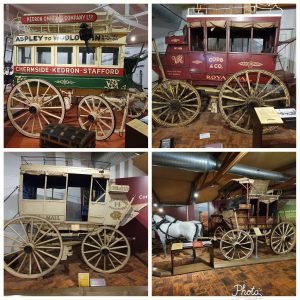
It is hard to overestimate the importance of Cobb & Co in the early days of the State of Queensland. The ‘open’ inland attracted many new settlers and within decades, after the Convict Settlement was closed, people started to arrive in Queensland moving from south to north and east to west. There were no roads, no reliable supplies, no communication, very little or no government services and so the list goes on. Often the company had to build parts of the road themselves, to be able to use the tracks. Mail contracts were linked to a timely delivery and penalties applied if they were not delivered within the allotted time period.
Most of the following information comes from the excellent book of Deborah Tranter: “Cobb & Co Coaching in Queensland”
While the local farmers and settlers started to organise themselves as best as possible, they simply couldn’t provide any meaningful overall system. It is here that the commercial organisation of Cobb & Co stepped in. Founded by the American Freeman Cobb, by the early 1850s he had organised regular coach services to and from the Victorian goldfields.
In 1865 they extended their service to include Queensland and within a decade they had established a mail coach network across the state. The commercial success of the coach service depended on mail contracts; passenger’s fees were extra. A range of other transport and messaging and communication services were provided by the coach drivers some for free some for a small extra charge.
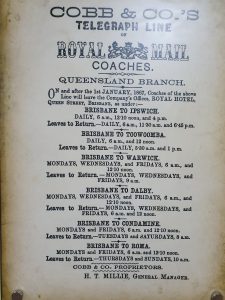
Over the two previous decades before Cobb & Co started a few transport services had been started often locally and using drays or sulkies with limited capacity and long transport times. It started in 1846 with Colonial Secretary’s Office adverting each year for tenders for the mail service between Brisbane and Ipswich. The first contractor was William Caswell, providing the service on horseback. The first mail coach was run by Mr. James. Collins, followed by C.Williams and James Wood, who held the contract for five years and operated the twice daily service with four coaches. Perhaps the most professional service that followed was the daily Royal Mail Service operated by John Nolan His business was acquired by Cobb & Co.
However, the coach services in Queensland were at the tail end of the golden age of mail and passenger coaches. They had started in Europe in the 17th century but on a more commercial basis they really took off in the late 18th century. By the time the service arrived in Queensland, the first railway from Ipswich to Toowoomba had just opened. And every bit of new rail infrastructure replaced the coach services that operated on those routes. After WWI the omnibus started to appear, and motorised transport started to replace the coach services to places not serviced by the railways. In 1929 the company went into voluntarily liquidation.
Hiram Barnes – ‘father’ of Cobb & Co Queensland
| Hiram Barnes was instrumental in starting the Queensland operation of Cobb & Co. In 1837, as a five year old, he came to Australia from Britain with his parents. Later he became involved in the gold-rush in Victoria, made his money and started his own coaching business. He later sold this to Cobb & Co. He was one of the Cobb & Co drivers who, in 1862, brought a convoy of 10 richly decorated coaches, two feed wagons and 103 horses from Sandgate in Victoria to establish new operations in NSW. Barnes took two coaches and 20 horses and established the operation between Forbes and Orange.
In 1865 he was sent to investigate business opportunities in SE Queensland. He visited Toowoomba where he looked into the various established transport services in the Darling Downs. In Brisbane he successfully negotiated the mail contracts with the Postmaster General, Thomas Murray Prior. This led to the formation of the Queensland branch of the company. Barnes took a 25% share in this partnership. He was widely respected as one of the best coachmen of the company and received the title ‘Knight of the Whip’. He was responsible for taking over competitors and the opening of all the new routes in Queensland. He was the first coachman of what would become the famous Gympie route. He never had a serious accident throughout his long career, a real feat considering the deploring state of the roads. Hiram died in 1917 aged 83 and a baptismal font at Kelvin Grove Methodist Church was dedicated to him and his wife Catherine. Their children included politicians G. P. Barnes, M.L.A. and W. H. Barnes (formerly State Treasurer), Fred Barnes, Mrs. John Reid, Mrs. Samuel Knowles, Mrs. B. A. Taudevin (of Melbourne), Mrs. Wagner, Mrs. Robert Kerr, Mrs. T. U. Symonds and Mrs. Henry Roberts. |
In the 70 years of operation in Queensland Cobb & Co contributed greatly to the transformation of this part of the world and played an enormous important role in transport and communication before proper roads, motorised transport and telecommunications became available to people beyond the larger cities.
In the context of this history, I will concentrate on the very early years of this coach service in and around Brisbane.
On New Year’s Day 1866 Cobb & Co started its service between Ipswich and Toowoomba, after the successful mail contract was secured. The service was operated with twenty horses and two American ten-passenger coaches. Negotiations with Nolan also secured the Brisbane – Ipswich route for Cobb & Co. Its head office was situated at 71 Albert Street.
Brisbane to Ipswich Route
| In Brisbane the coach left from Young’s Royal Hotel in Queen Street opposite the post office on the corner with George Street. From here it crossed the recently opened Victoria Bridge, however, after its collapse the coach had to be ferried across the river. When the new bridge was finally opened in 1874 the Cobb & Co coach was the first vehicle to cross the bridge.
Once on the other side of the river the trip continued to Nolan’s Royal Mail Hotel on the southwest corner of Stanley and Russell Streets, South Brisbane. From here it followed the newly surveyed Coach Road to Ipswich, largely following the old convict track. There were horse changing stations at Oxley Creek and at Goodna. |
A fatal accident occurred during a severe storm on the above-mentioned route on 26 October 1866. After it had dropped of its passengers in Queen Street it continued to South Brisbane where it at Stanley Street the coach and its five horses toppled over the embarkment. One of the employees John Daly, died in the accident.
The following year bushrangers ambushed the coach near Oxley Creek.
These are the only incidents that I have come across in Brisbane, obvious many more happened at other places of the State.
As the first part of Ipswich to Toowoomba trainline was finished by the time the coach service started to operate, the trip from Ipswich to Grandchester (Bigge’s Camp) was done by train. Cobb & Co picked up the service from what was then the end of the line and continued from here to Toowoomba. When in 1867 the train line reached Toowoomba this coach services ceased operation. They continued with Brisbane-Ipswich route till 1875 when also this stretch of the railway line was finished.
The best-known Cobb & Co route in Queensland was Brisbane – Gympie, opened in 1868, followed by the discovery of gold a year earlier. It was Hiram Barnes who was the driver of the first trip. Later Barnes mentioned that the welcome in Gympie could not have been heartily if he had been the Governor of the State.Staging posts in the Brisbane area included: Bald Hills, Petrie (see below), Burglary Creek and Caboolture. It took two long days over terrible roads (read tracks) to reach Gympie. The service operated till 1879, when the train also arrive here. There is some more interesting information on this route.
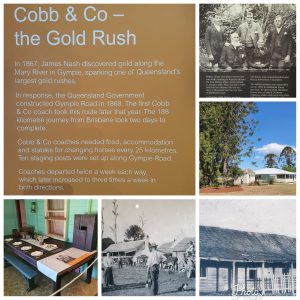
In 2021 we visited one of the last Cobb and Co staging post in the Brisbane area. Bankfoot at Glasshouse Mountains. Rather than spending his money on digging for gold Scotsman William Grigor established in 1868 a staging post on the new Brisbane to Gympie Route. While William earned his money as a timbergetter and with bullock transport, his wife Mary Fenwick did run the station post. The station is now a museum.
With the sudden interest in Gympie a bridge was constructed over the Kedron Brook in Brisbane to permit an alternative northerly route. This route would become known as Gympie Road. In 1868, the Edinburgh Castle Hotel was built by George Orr, which also became the staging site for Cobb & Co. The horses were swapped across Gympie Rd where the stables were situated.
Tom Petrie played an important role in the early history of Brisbane as I have covered elsewhere. He established his homestead Murrumba on a bend on the Pine River in 1858. Tom Petrie’s occupation of Murrumba was the catalyst for further non-indigenous settlement of the North Pine district. In 1869 Cobb & Co opened a coach route from Brisbane to Gympie via the route Tom had helped mark out, and a staging post was established temporarily at Murrumba Homestead until Tom erected a hostelry on portion 29 (by 1870). This was later licensed as the North Pine Hotel.
Coachman Alexander McCallum on the Gympie Run
| The Great Great Grandfather of one of my Brisbane History friends Russell Thompson, Alexander McCallum, was a post office employee at Fortitude Valley before acquiring the Cobb and Co, Mail/Coach run from Caboolture to Nanango, through the Brisbane Valley. He also had various other runs including toward Gympie.
Fiona Byers (Brisbane History friend), Great Great Grandfather, William Carseldine had a property at Bald Hills (East of St Paul’s) and his family acquired another block at the Corner of Beams Road. The family built the first road between the two homes. Alexander McCallum drove his Cobb and Co Coach along this road. His also is know to have driven the Esk pub to Nannango. His son also named Alex was also a coachman, his father later on was more involved in the pubs that build and exploited. Alex Sr’s father Daniel, was a convict who stayed in Brisbane. |
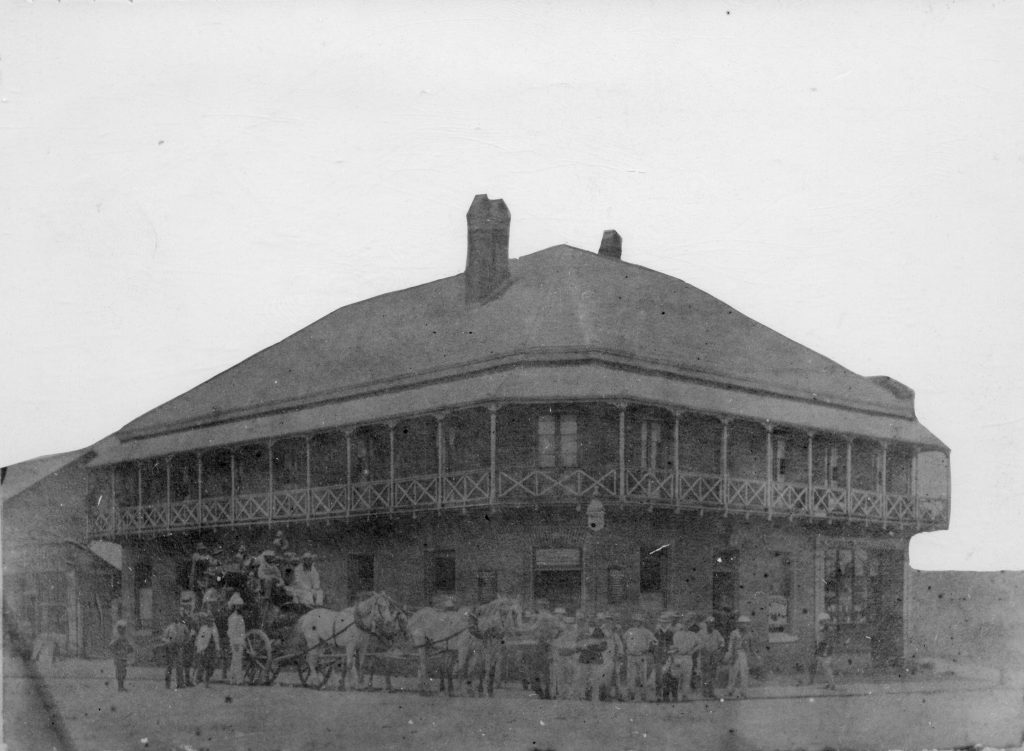
The photo above is the only one that I have come across of Cobb & Co’s activities in Brisbane.
From 1870 – till 1888 the company ran a service from Brisbane originally to Pimpama, later extended to South Port. Changing stations along this route included: Mt Gravatt, Eight Miles Plains, Waterford, Loganholme, Beenleigh, Yatala, Coomera and Nerang, Eventually it extended to Tweeds Head and beyond.
Coachman Thomas Tucker
| One of my Brisbane History friends Brenda Koster mentioned that the lady who lived next to her grandparents’ holiday house at Kirra was the daughter of a Cobb & Co Coach driver. Thomas Tucker was born in Co Limerick in 1840 and died in the Diamantina Hospital in Brisbane in 1918. When he was living in Beenleigh in the mid 1880’s his occupation was given as Coachman. |
The history of Logan also mentioned some Cobb & Co history. It talks about a hotel that existed on the corner of Teviot Road and Pub Lane. It was a changing station for the Cobb and Co. Coaches travelling to Beaudesert via the Old Paradise Road between Acacia Ridge and Jimboomba. Graeme Willox mentioned that there is still a house on the western side of Teviot Road at Greenbank, just south of Pub Lane. Where he was told by several people years ago that it had previously been a changing station for Cobb & Co. Due to the number of rivers between Brisbane and northern New South Wales, and the lack of engineering expertise in the area at the time, Teviot Road was at that time one of the main routes between Sydney and Brisbane.
A service to Sandgate operated from 1876 till 1879. With staging posts at Albion and German Station (Nundah).
While Cobb & Co coached disappeared from the streets of Brisbane the service flourished elsewhere. With more and more people settling further into the state, the development of agriculture and the discovery of gold the golden age for Cobb & Co were between 1880 and 1910.
Brisbane remained the place of the head office of the company. In the 1880s the company established offices, a coach building factory and stables at Petrie Bight, opposite the ferry. While the factory moved to Charleville, the rest of the Brisbane operation continued until the liquidation of the company in 1929.
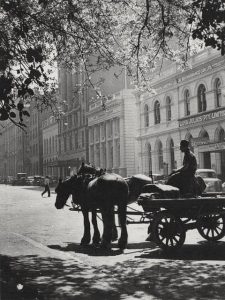
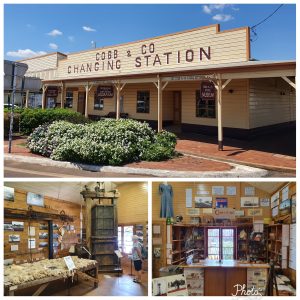
However, after it’s liquidation the name of Cobb & Co continued to be used. The company never properly protected their brand. Even when they were still operating former employees used the name for their own store or transport business, and such example in the picture to the left. In this case it is Redmans’ Cobb and Co. A truck and Bus/Coach business till at least the late 70’s.
The history of Cobb & Co is still nurtured everywhere, it has a romantic feel about a forgone era. As the networks was so wide spread many towns throughout outback Australia do still have artifacts on display in their local museums and heritage rooms. Toowoomba in Queensland has a large museum totally dedicated to the company. In Surat, outback Queensland the former Cobb & Co store and changing station has been transformed into a museum that is very worthwhile visiting.
The Surat to Yuleba Route 177, warrants extra attention. It was the most famous one in Queensland. In 1880 Cobb & Co did win the mail contract on this route, replacing the services of the independent operators. Originally it covered a distance of 203 kms. It was on this route that the company ran its very last coach in 1924.
I posted my story on the Old Brisbane Facebook Site and received many reaction which I researched further and the results have been included in the story above.
The historic development of the coach station system
| The start of the system in Europe dates to Roman times, be it just based on riders rather than coaches. Roads had regularly spaced stations along their length – the Roman equivalent of motorway service areas. Roughly every 4 mi (6.4 km) – the most a horse could safely be ridden hard – there would be a mutatio (literally: “a change”), essentially stables where mounted messengers could change horses and a tavern to obtain refreshment.
Relays of fresh riders and horses careering at full gallop could sustain an average speed of about 20 mph (32 km/h). Thus, an urgent despatch from the army base to the headquarters over for example 200 mi (320 km), a journey of over a week for a normal mounted traveller – could be delivered in just 10 hours. This system roughly continued – even using many of the old Roman Roads – for transport in Europe in the following centuries and from the 17th century onwards with coaches, first only for the nobility and later also for other passengers. Approximately every 12 mi (19 km) – a typical day’s journey for an ox-drawn wagon – was a mansio (from which derived the English word “mansion” and French maison or “house”). This was a full-scale wayside inn, with large stables, tavern, rooms for travellers and even bathhouses in the larger establishments. Looking at the distribution of hotels and even inland towns along the Cobb & CO stations in Australia there are amazing similarities with the distribution of Roman and later European hotels and changing stations, distances of around 5km between pubs and 20 km between larger hotels with changing stations were still the norm. The arrival of motorised transport ended this millennia old system. See also: Cobb & Co coaching between Brisbane and Gympie
|